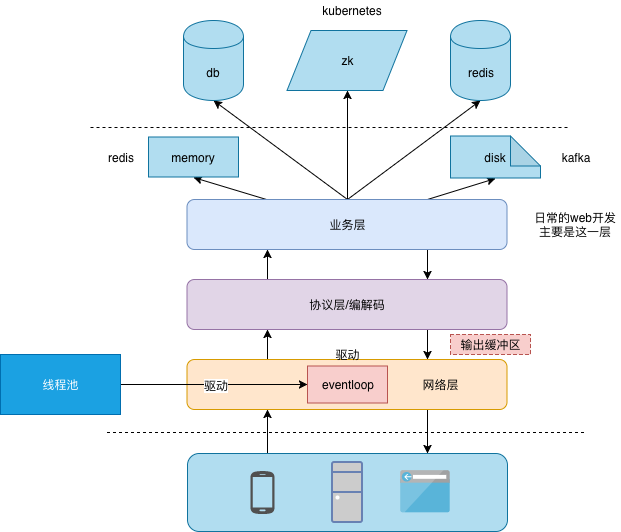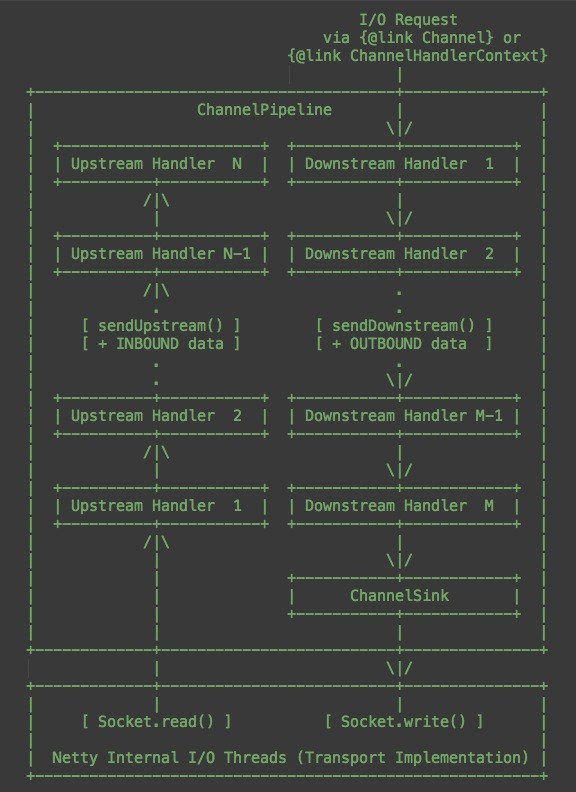前言
- 前言
- netty 与 tomcat 对比理解
- java nio channel
- netty channel
- channel 和 unsafe的关系
- pipeline
- eventloop
- channel 以及 unsafe pipeline eventloop 三国杀
- 小结
借用知乎上”者年”关于java nio技术栈的回答如何学习Java的NIO
- 计算机体系结构和组成原理 中关于中断,关于内存,关于 DMA,关于存储 等关键知识点
- 操作系统 中 内核态用户态相关部分, I/O 软件原理
- 《UNIX网络编程(卷1):套接字联网API(第3版)》([美]史蒂文斯,等)一书中 IO 相关部分。
- Java I/O底层是如何工作的?
- 存储之道 - 51CTO技术博客 中的《一个IO的传奇一生》
- Operating Systems: I/O Systems4.
- 多种I/O模型及其对socket效率的改进
根据这个思路,笔者整理了下相关的知识,参见java io涉及到的一些linux知识
服务端网络开发的基本套路

netty 与 tomcat 对比理解
有一个本书叫《how tomcat works》,从几行代码开始,一步一步的叙述tomcat的实现。我们通过对照,就可以发现此类网络通信框架,要处理或涉及的一些共同问题。
- io 模型
- 线程模型,以及io模型与线程模型的结合问题
- 组件化的数据处理模型,对netty是channelhandler,对tomcat是fillter和tomcat
- 元数据配置,此类系统都需要传入大量的参数,配置文件的形式是什么,如何读取,又如何在各个组件之间流转。
- 即使功能已经非常强大,仍然要上层框架支持以完成复杂的业务逻辑。对tomcat是spring mvc等,对netty则是一系列的rpc框架。
java nio channel
java源码中channel的注释:A nexus(连结、连系) for I/O operations。
不管是os提供的系统调用,还是c提供的一些库api,本质都是一系列函数,移植到java中需要一个对象来负责使用这些函数。PS:很多时候,作者在源码上的注释,本身就很精练、直接,比博客上的赘述要好很多。
Channel用于在字节缓冲区和位于通道另一侧的实体(通常是一个文件或套接字)之间有效地传输数据。
| client | server |
|---|---|
| java buffer <==> java channel <==> system socket send/receive buffer | system socket send/receive buffer <==> java channel <==> java buffer |
Java NIO Tutorial In the standard IO API you work with byte streams and character streams. In NIO you work with channels and buffers. Data is always read from a channel into a buffer, or written from a buffer to a channel.
channel的io操作本身是非阻塞的,要想不无的放矢,就要借助selector。
netty channel
A nexus to a network socket or a component which is capable of I/O operations such as read, write, connect, and bind.
- All I/O operations are asynchronous.
- Channels are hierarchical
下文以AbstractChannel为例来说明这个两个特点:
AbstractChannel{
Unsafe unsafe;
DefaultChannelPipeline pipeline;
EventLoop eventLoop;
ChannelFuture succeededFuture;
CloseFuture closeFuture;
}
asynchronous
所有的io操作都是异步,那么有channelFuture就是理所当然了。因为即便是异步,也得告诉你什么时候写完了,什么时候读完了,以及r/w之后做什么,这时就需要一个nexus对象(callback或future)。并且,对于异步来说,可能A线程触发读操作,而实际处理读到数据的是B线程。
单纯的nio,是不支持异步的(channel只是搬运buffer罢了,你并不能告诉channel,数据写完了通知你一声儿),这就意味一系列的封装操作。并且netty channel不同方法的封装方式是不一样的。比如,AbstractChannel有一些future成员,为什么呢?read、write、connect等操作的future的返回是AbstractChannel具体负责io的unsafe、pipeline等成员负责。剩下的close(channel作为一个facade类,聚合了多个组件,close操作涉及到多个组件)等操作,由AbstractChannel亲自维护future。
hierarchical
Channels are hierarchical有以下个含义
- channel具有父子逻辑,比如一个socketChannel的父可能是一个serverSocketChannel
- channel有一套继承结构
- channel聚合了大量功能类,在接口层采用facade模式统一封装
从这里就可以看到,netty的channel不再是java nio channel那个只负责r/w操作的纯洁的小伙儿了,这个channel更应该叫Endpoint(Client/server)或channelFacade更合适。
ChannelPool
上层接口
- ChannelPoolHandler,Handler which is called for various actions done by the ChannelPool.ChannelPool的很多操作完成后会触发
- ChannelHealthChecker, Called before a Channel will be returned via ChannelPool.acquire() or ChannelPool.acquire(Promise). 在用户通过acquire方法获取channel的时候,确保返回的channel是健康的。
- ChannelPool,Allows to acquire and release Channel and so act as a pool of these.
-
ChannelPoolMap,Allows to map ChannelPool implementations to a specific key.将channelpool映射到一个特殊的key上。这个key通常是InetSocketAddress,记一个地址映射多个channel。
public interface ChannelPool extends Closeable { Future<Channel> acquire(); Future<Channel> acquire(Promise<Channel> promise); Future<Void> release(Channel channel); Future<Void> release(Channel channel, Promise<Void> promise); void close(); }
ChannelPool有两个简单实现simplechannelpool和FixedChannelPool,后者可以控制Channel的最大个数。但相对于common-pool,其在minActive,minIdle等控制上还是不足的。所以笔者在实现时,最终还是选择基于common-pool2实现基于netty的channel pool。
基于common-pool2实现基于netty的channel pool需要注意的是:
- 空闲Channel的连接保持。一个简单的解决方案是心跳机制,即向channel的pipeline中添加发送与接收心跳请求与响应的Handler。
- common-pool 池的存储结构选择先进先出的队列,而不是先进后出的堆栈。
channel 和 unsafe的关系
Unsafe operations that should never be called from user-code. These methods are only provided to implement the actual transport, and must be invoked from an I/O thread except for the following methods:localAddress(),remoteAddress(),closeForcibly(),register(EventLoop, ChannelPromise),voidPromise()
每一个channel都大体对应一个unsafe内部类/接口。
| channel | unsafe |
|---|---|
| Channel | Unsafe |
| AbstractChannel | AbstractUnsafe |
| AbstractNioChannel | NioUnsafe,AbstractNioUnsafe |
| AbstractNioByteChannel | NioByteUnsafe |
netty channel作为对nio channel的增强,有两种增强方式:
- 继承nio channel。但java nio channel是spi类接口,扩展不易。
-
重写,在实际读写的位置调用nio channel,最简单的方案:包含
write(buffer){ business1 java.nio.channel.write(buffer) business2 }
而netty channel却采用了聚合的方式,将实际的读写交给unsafe,有以下几个好处:
- 不跟netty channel(作为facade)的其它代码、成员放在一起。unsafe更纯粹的组织读写代码。
- netty channel除了网络io,还有线程模型(eventloop)、数据处理模型(pipeline),rw代码交给unsafe后,netty读写就是unsafe、eventloop和pipeline的三国杀,netty channel在外边统筹兼顾。否则,netty channel和eventloop、pipeline就糅合在一起,纠缠不清了。
因此,理解netty channel,就要理解unsafe、pipeline和eventloop的三国杀。我们反过来想想,正是理清了这三者的关系,unsafe、pipeline和eventloop才有了自己的继承体系,最后被netty channel揉和在一起。
pipeline
A list of ChannelHandlers which handles or intercepts inbound events and outbound operations of a Channel. ChannelPipeline implements an advanced form of the Intercepting Filter pattern to give a user full control over how an event is handled and how the ChannelHandlers in a pipeline interact with each other.
inbound 的被称作events, outbound 的被称作operations。

从这个图就可以佐证,pipeline作为数据处理模型,不介入io模型,也不介入线程模型。
eventloop
存在形式
使用红框标出了重点部分:PS: 下面的思维方式很重要
- ScheduledExecutorService 接口表示是一个定时任务接口,EventLoop 可以接受定时任务。
- EventLoop 接口:Netty 接口文档说明该接口作用:一旦 Channel 注册了,就处理该Channel对应的所有I/O 操作。
- SingleThreadEventExecutor 表示这是一个单个线程的线程池。
一个 EventLoop 将由一个永远都不会改变的Thread 驱动,同时任务(Runnable 或者 Callable)可以直接提交给 EventLoop 实现,以立即执行或者调度执行。根据配置和可用核心的不同,可能会创建多个 EventLoop 实例用以优化资源的使用,并且单个 EventLoop 可能会被指派用于服务多个 Channel(PS: 但一个channel只归属一个EventLoop,以线程安全)。
eventloop.execute(task) 实现,主要这段代码由调用线程执行
public void execute(Runnable task) {
boolean inEventLoop = inEventLoop();
if (inEventLoop) {
addTask(task);
} else {
startThread();
addTask(task);
if (isShutdown() && removeTask(task)) {
reject();
}
}
if (!addTaskWakesUp && wakesUpForTask(task)) {
wakeup(inEventLoop);
}
}
首先判断该 EventLoop 的线程是否是当前线程,如果是,直接添加到任务队列中去,如果不是,则尝试启动线程(但由于线程是单个的,因此只能启动一次),随后再将任务添加到队列中去。如果线程已经停止,并且删除任务失败,则执行拒绝策略,默认是抛出异常。
EventLoop 中的 Loop 到底是什么?
protected void run() {
for (;;) {
switch (...) {
case SelectStrategy.CONTINUE:
...
case SelectStrategy.SELECT:
this.select(this.wakenUp.getAndSet(false));
...
default:
cancelledKeys = 0;
needsToSelectAgain = false;
final int ioRatio = this.ioRatio;
if (ioRatio == 100) {
try {
processSelectedKeys();
} finally {
runAllTasks();
}
} else {
final long ioStartTime = System.nanoTime();
try {
processSelectedKeys();
} finally {
// Ensure we always run tasks.
final long ioTime = System.nanoTime() - ioStartTime;
runAllTasks(ioTime * (100 - ioRatio) / ioRatio);
}
}
}
// Always handle shutdown even if the loop processing threw an exception.
...
}
}
整个 run 方法做了3件事情:
- selector 获取感兴趣的事件。
- processSelectedKeys 处理事件。
- runAllTasks 执行队列中的任务。
在 Netty 中,有2种任务,一种是 IO 任务,一种是非 IO 任务,ioRatio 的作用就是限制执行任务队列的时间。
private void select(boolean oldWakenUp) throws IOException {
Selector selector = this.selector;
int selectCnt = 0;
long currentTimeNanos = System.nanoTime();
long selectDeadLineNanos = currentTimeNanos + this.delayNanos(currentTimeNanos);
while(true) {
long timeoutMillis = (selectDeadLineNanos - currentTimeNanos + 500000L) / 1000000L;
if (timeoutMillis <= 0L) {
if (selectCnt == 0) {
selector.selectNow();
selectCnt = 1;
}
break;
}
if (this.hasTasks() && this.wakenUp.compareAndSet(false, true)) {
selector.selectNow();
selectCnt = 1;
break;
}
int selectedKeys = selector.select(timeoutMillis);
++selectCnt;
if (selectedKeys != 0 || oldWakenUp || this.wakenUp.get() || this.hasTasks() || this.hasScheduledTasks()) {
break;
}
if (Thread.interrupted()) {
selectCnt = 1;
break;
}
long time = System.nanoTime();
if (time - TimeUnit.MILLISECONDS.toNanos(timeoutMillis) >= currentTimeNanos{
selectCnt = 1;
} else if (SELECTOR_AUTO_REBUILD_THRESHOLD > 0 && selectCnt >= SELECTOR_AUTO_REBUILD_THRESHOLD) {
this.rebuildSelector();
selector = this.selector;
selector.selectNow();
selectCnt = 1;
break;
}
}
}
整段代码都在弄一个事情:是selector.selectNow(); 还是 selector.select(timeoutMillis)
这段逻辑可不孤单,Redis源码分析 中的eventloop 异曲同工
channel 以及 unsafe pipeline eventloop 三国杀
Channel是netty提供的操作对象,其能力是通过聚合unsafe、pipeline和eventloop来实现的。 也即是说,channel只是外皮,分析unsafe、pipeline和eventloop的相互作用才是学习Netty的关键。
eventloop 有一个selector 成员,selector.select() 得到selectorKey,selectorKey 可以获取到channel(channel执行 SelectionKey register(Selector sel, int ops, Object att)时会将自己作为attr传入),进而通过channel得到unsafe进行读写操作。(channel提供的操作能力,一方面供coder使用,一方面供eventloop使用)
对于读取,是eventloop ==> channel.unsafe.read ==> channel.pipeline.fireChannelRead(byteBuf);
对于实际的写,eventloop ==> unsafe.forceFlush()
也就是说,三国杀里,eventloop只需负责在合适的时间通过channel操作unsafe==>pipeline或pipeline ==> unsafe即可。
对于写,则是 channel.write ==> pipeline.writeAndFlush(msg) ==> HeadContext.write ==> unsafe.write ==> outboundBuffer.addMessage
java nio channel每次读写都要缓冲区。对于netty channel来说(具体是unsafe),读缓冲区是读取时临时申请一个buffer,写则事先分配的一个缓冲区。
一个channel自打注册到selector后,不是一直interest r/w事件的,比如out buffer有数据了才关心,没数据了就remove interest,这样可以提高性能。
小结
一个稍微复杂的框架,必然伴随几个抽象以及抽象间的依赖关系,那么依赖的关系的管理,可以选择spring(像大多数j2ee项目那样),也可以硬编码。这就是我们看到的,每个抽象对象有一套自己的继承体系,然后抽象对象子类之间又彼此复杂的交织。比如Netty的eventloop、unsafe和pipeline,channel作为最外部操作对象,聚合这三者,根据聚合的子类的不同,Channel也有多个子类来体现。
同时,做一个粗略的对应
| 模型 | 代码抽象 |
|---|---|
| io模型 | unsafe |
| 线程模型 | eventloop |
| 数据处理模型 | pipeline |